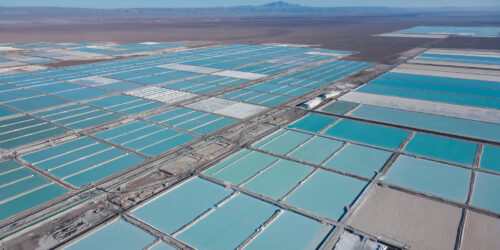At least 30 times as much lithium, nickel and other key minerals may be required by the electric car industry by 2040 to meet global climate targets, according to the International Energy Agency (IEA).
These metals are among a handful that are considered vital in the manufacture of solar panels, wind turbines and other clean energy technologies.
Overall, the Paris-based organisation says the production of these key minerals may need to quadruple over the next two decades to achieve the Paris Agreement target of limiting warming to “well below” 2C, or expand by as much as six times to reach net-zero globally by 2050.
Its new report examining the status of these minerals concludes that today’s supply and investment plans “fall short” of what will be necessary for a widespread clean energy transition.
The IEA report examines the barriers – some of which have previously been covered by Carbon Brief – that could prevent the mineral industry from scaling up to meet this future demand.
However, in an introduction to the report, IEA executive director Dr Fatih Birol writes:
“These hazards are real, but they are surmountable. The response from policymakers and companies will determine whether critical minerals remain a vital enabler for clean energy transitions or become a bottleneck in the process.”
Higher demand
Broadly speaking, the mineral demands of clean energy technologies are greater than their fossil-fuelled counterparts, the IEA says.
This can be seen in the chart below, which shows how an offshore wind plant today requires around 12 times more mineral resources than an equivalent gas plant.
According to the IEA, the rise of renewable power in recent years means that since 2010 the average amount of these minerals required for a new unit of power generation capacity has increased by 50%.
In its new report, the agency assesses future demand for these metals in different energy applications under two different scenarios, which see overall demand either doubling or quadrupling, as the chart below shows.
First is the IEA’s “sustainable development scenario” (SDS), which it says is aligned with the Paris Agreement target of holding warming at “well-below 2C”.
While the IEA’s SDS and its alignment with the Paris Agreement has been disputed, the report also mentions a “dramatic extra push” needed to achieve global net-zero by 2050. The agency is expected to release a “comprehensive roadmap to net-zero emissions by 2050” in the coming weeks.
The new report also uses the “stated policies scenario (STEPS)”, which “provides an indication of where today’s policy measures and plans might lead the energy sector”.
It combined clean energy trends primarily from the World Energy Outlook 2020 with new analysis of changes in mineral usage based on “extensive literature review, and expert and industry consultations”.
Under the SDS in particular, clean energy technologies’ share of total mineral demand is set to rise significantly, becoming the primary market for nickel, cobalt and lithium. This can be seen in the graph below.
Material needs
Electric vehicle batteries and battery storage are expected to be by far the biggest contributor to the future surge in demand, with lithium, nickel, cobalt, manganese and graphite all crucial for ensuring performance, longevity and energy density.
In the SDS, mineral demand from the battery sector grows around 30-fold by 2040. Lithium and nickel demand for electric vehicle batteries alone grows by 43 and 41 times, respectively.
This projected growth can be seen in the charts below.
Low-carbon power generation also accounts for a considerable chunk of the future growth in mineral demand, with rare earth elements currently needed for permanent magnets in wind turbines and EV motors, for example.
As societies become increasingly electrified, the expansion of electricity networks will also require large quantities of copper and aluminium.
The IEA notes that future mineral demand is “subject to considerable uncertainty” due to both the extent of climate policies and the direction that different technologies take. For example, mineral requirements can shift in response to market prices or the commercial success of one technology over another.
To address this, the agency assessed 11 alternative cases that account for some of the potential variability in different sectors. These can be seen in the table below.







